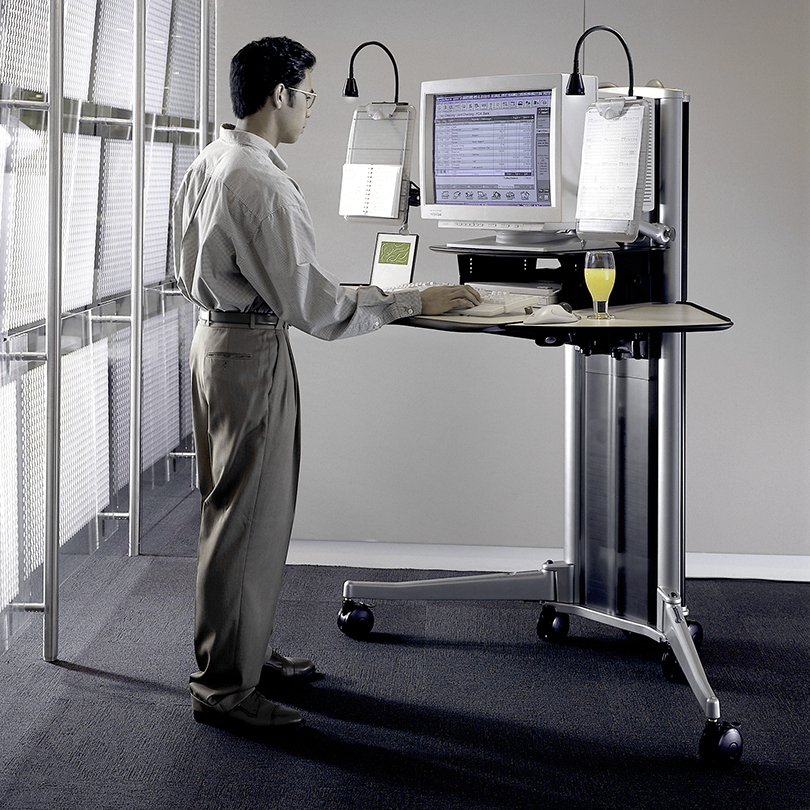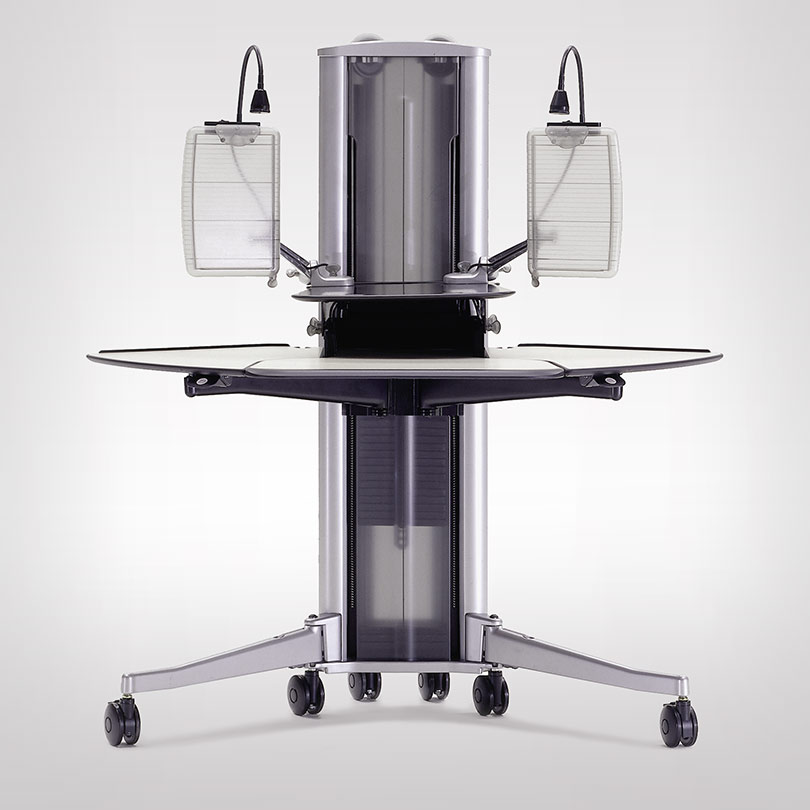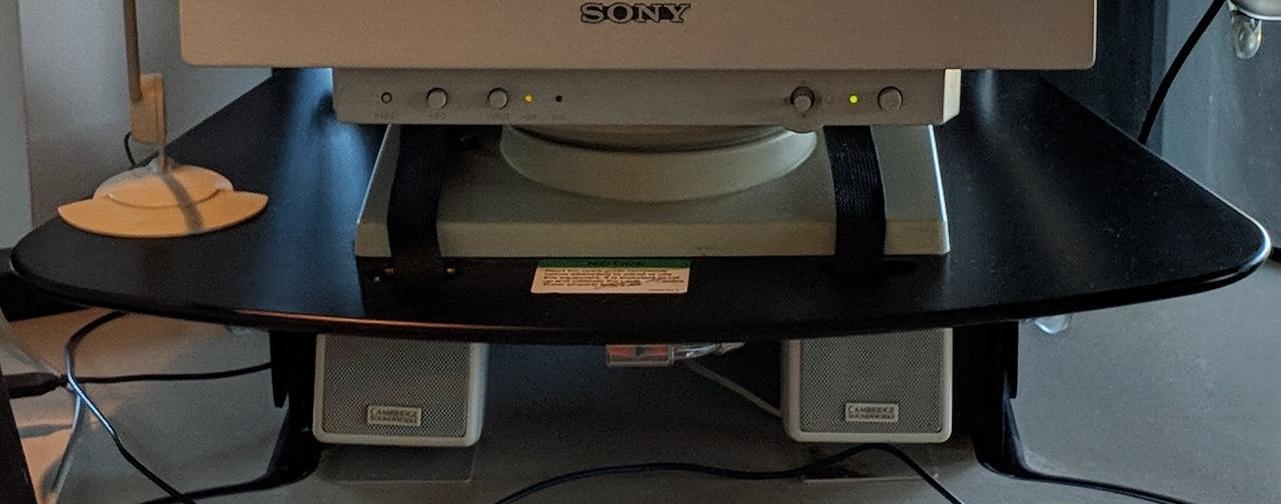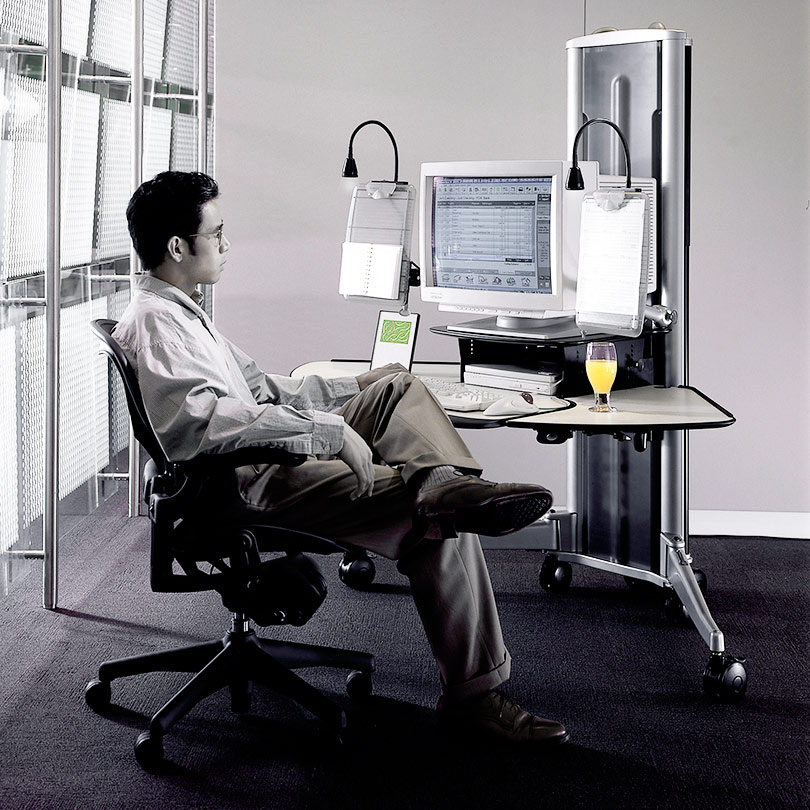For months I tried to give my old adjustable desk to a museum, or at least to someone who has a use for it. It’s the Levity by Herman-Miller, an impressive piece of late 90s office design. It goes from
to

The backstory
I’ve stood to work at a computer for decades, long before it was trendy. I set up computers on lab racks, I put file cabinets on my desk to lift up monitors, I raised cubicle desk surfaces as high as they could be mounted.
Then in 1999 the great furniture company Herman Miller announced the Levity desk, designed by Richard Holbrook. Finally a computer desk that could be adjusted to different positions! This was a hard problem back then because computer monitors were all CRT (cathode ray tube) designs, and big ones (over 20 inches) could weigh hundreds of pounds. To address this the Levity desk incorporated hundreds of pounds of counterweights:

I assume these first three photos are copyright 1999 HermanMiller.
You can see the stack of weights below the desk behind the smoke-gray plastic cover. This is a weightlifting apparatus linked by pulleys to a work surface.
The desk got a lot of attention and won a Gold Award at NeoCon for Innovation, and was included in the Workspheres exhibition at the Museum of Modern Art in New York. But then the desk took two years to ship, I think due to OSHA workplace safety concerns. If you put a heavy monitor on the desk without counterbalancing it, it might slam down on you while adjusting the height; conversely if you took heavy stuff off the desk without changing the weight stack, it might shoot upwards to punch you in the jaw. Herman-Miller added a balance indicator to warn if the desk is out of balance, earthquake straps to secure the computer monitor, and lots of safety warnings:

is it safe to adjust the height?
So I finally took delivery in 2001, paying $3,600 for the desk. (!!) A lot of money, but I spent more hours at this desk than I did sleeping, so money well spent. The thing worked really well.
Herman-Miller’s concept for the desk involved moving it around in space as well as up-and-down. The brochure talks of “knowledge athletes” (gag me with a spoon!) moving their desks around to form ad hoc workgroups, and the Levity line included two kinds of carts for trucking your computer workstation around along with the desk to work on projects with other knowledge athletes. In the real world, the office furniture supplier rolled the desk into my cubicle at work, where it stayed put until I changed location in corporate reorgs. The Levity is a quarter circle with a 4 foot radius, so it fit perfectly into a 8×8 foot cubicle built of 48″ panels: just remove one desk surface. Then my company downsized our veal fattening pens to 42″ panels; the symmetry was gone, but I made it work.

my Levity desk, 20 years later
I eventually brought the desk home where it saw use as a sit-to-stand desk for a laptop plugged into an external Sony GDM-F400 monitor. You can see the collision of the designer’s Platonic form with the real world: all the cables that a desktop computer requires, for power, microphone, computer speakers, Ethernet, in addition to the transformers for the two lit workholders. My Levity came with a black zippered sock for cable management but it’s impossible to organize all the cables in one place.
A beautiful white elephant
In retrospect it’s obvious this 380 pound behemoth was a dead end. Flat lightweight LCD monitors were already available and dominated boxy CRTs by the early 2000s. Meanwhile so-called “knowledge athletes” were carrying lightweight laptops around, and the need to support hundreds of pounds of weight vanished. Desks no longer needed to be several feet deep to permit a big CRT.
Some day I’ll write about all my other adjustable desks: the Biomorph Exo home desk (as advertised in the back pages of WIRED magazine), the ConSet wall-mounted motorized column I added to a custom work surface, the lightweight Ergotron WorkFit-C desk I last used at work that weighs a sixth of the Levity, …
Postscript: yours for $25, a steal!
After giving up on museums, I offered it for sale. I was briefly excited by someone offering one for sale in 2016 for $1300 ! and someone else claiming in comments “This desk is worth upwards of 5,000$ if its mint. Hunt around carefully before you sell it low ball. I … sold one for 6500 and got > 5k$ after agent commission.” But I didn’t get a single bid on eBay at $300. I got lots of interest on Craigslist until people realized just how big a 4-foot quarter circle is and how hard it is to transport a 350-pound piece of furniture. Finally someone with a trailer and a loading ramp bought this classic for $25. (And an artist paid $20 for the monitor to directly drive its cathode-ray tube like an oscilloscope in an art piece.)
Related pages
- A 1999 article in CIO magazine about future workplaces.
- Richard Holbrook’s page about his Levity design.


Hi,
I am now in your old boat. My husband has one of these on the 3rd (!) floor of our house and we are moving. I need to get it down to the garage where I hope I can at least give it away. I have tried to find instructions on how to get the weights out so that it can be moved but so far no luck. Do you by any chance remember how you disassembled and moved it? Any hints would be so appreciated!
Hi!
The first step is to disconnect as many weights as possible from the cables. This is in the instruction manual. Move the work surface to the highest location, take everything off it, remove the plastic cover over the weight stack, lift up the lever so you can unpin stuff from the weight stack. Then… I think you can remove the weight pin and stick it back in with just a few counterweights attached.
Next step is to remove the weights. Lower the work surface a bit, then I think I just lifted each weight in turn up and turned it sideways and was able to extract it. They’re oily, so have a sturdy box ready for them.
With many of the weights removed the desk still weighs hundreds of pounds. My only advice is get a team of movers… so you’ll probably pay to get rid of it.
Many Many years later.
You wouldn’t happen to have a manual for the Levity?
I was bequeathed one (it is quite neat!) but I need some help on how to operate it!
thankx
Sorry, I gave all the materials I had to the person who finally bought the desk. I tried using the Internet Archive’s Wayback Machine site to browse the 2001 hermanmiller.com site, but I couldn’t navigate to a support section or to a Levity page. Maybe there’s a way to do a Google search on the Herman Miller Levity restricted to pages authored 2000-2004 and hope someone linked to a specific Herman Miller page that you could then locate on the Wayback Machine.
Someone asked the same question in 2023 on the Reddit Herman Miller sub, and got no replies.